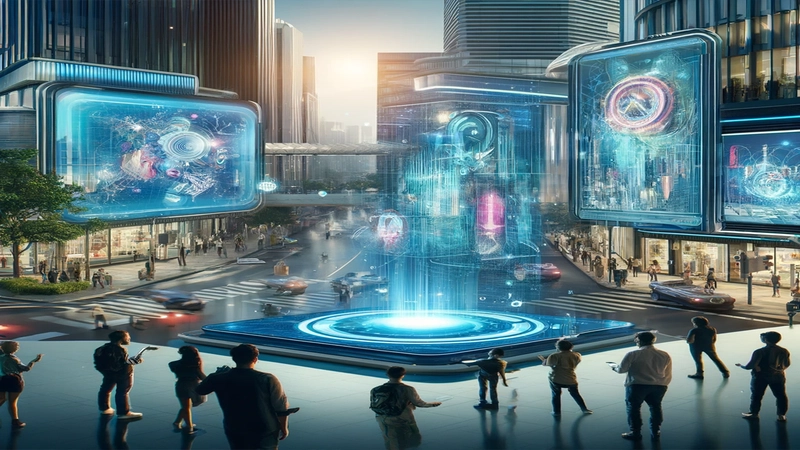Introduction
In the fast-evolving world of advertising, brands are constantly seeking innovative ways to capture audience attention. Why Holographic Displays are the Future of Digital Advertising is a question that industry leaders are now taking seriously. These futuristic displays offer a unique, immersive experience that traditional advertising methods cannot match. As 2025 approaches, businesses are increasingly investing in holographic technology to redefine customer engagement and brand storytelling.
The Rise of Holographic Displays in Advertising
Holographic displays have revolutionized digital advertising by bringing 3D, interactive visuals to life. Unlike conventional screens, holographic technology creates an illusion of depth, making advertisements more engaging and memorable. Brands leveraging this technology gain a competitive edge in consumer engagement and brand recall.
How Holographic Displays Work
Holographic advertising utilizes cutting-edge light diffraction techniques to project three-dimensional images into space. With the help of AI and augmented reality (AR), these visuals interact with the environment, creating an engaging experience for consumers. As a result, businesses can create immersive campaigns that captivate audiences like never before.
Key Benefits of Holographic Displays in Digital Advertising
1. Enhanced Consumer Engagement
Holographic ads create an interactive and immersive experience, increasing user engagement and making brand messages more impactful.
2. High Retention and Brand Recall
Consumers are more likely to remember a product showcased through a holographic display than one presented via traditional media.
3. Eliminating the Need for Physical Screens
Holographic technology eliminates the constraints of traditional digital screens, allowing advertisements to appear in open space and creating a more dynamic viewing experience.
4. Increased Conversion Rates
Studies show that interactive ads significantly improve conversion rates, making holographic displays a game-changer in digital advertising.
5. Cost-Effective and Scalable Solutions
While the initial investment in holographic technology may be high, its long-term benefits outweigh costs. Holographic ads can be updated digitally without additional printing or deployment costs.
Industries Benefiting from Holographic Advertising
1. Retail and E-Commerce
Retail brands use holographic displays to showcase products in 3D, allowing customers to explore product features before purchasing.
2. Automotive Industry
Car manufacturers leverage holographic advertising for virtual showrooms, enabling potential buyers to interact with vehicles remotely.
3. Entertainment and Events
Concerts, exhibitions, and sports events integrate holographic ads for interactive audience experiences.
4. Healthcare and Pharmaceuticals
Medical brands use holographic advertising to demonstrate product efficacy and medical procedures.
5. Hospitality and Real Estate
Hotels and real estate developers utilize holographic ads to provide virtual tours and interactive property showcases.
The Future of Holographic Displays in Digital Advertising
With AI, AR, and machine learning advancements, holographic advertising is set to become mainstream. Brands investing in this technology today will lead the future of customer engagement. As 5G technology enhances data transmission speeds, holographic ads will become more seamless and accessible across digital platforms.
Challenges and Considerations
While holographic advertising holds great promise, some challenges must be addressed:
- High initial costs: Developing and deploying holographic displays requires significant investment.
- Technical limitations: The technology is still evolving and requires improvements in resolution and scalability.
- Consumer adaptation: As with any emerging technology, widespread adoption will take time.
Conclusion
Why Holographic Displays are the Future of Digital Advertising is a question that brands must seriously consider in 2025 and beyond. As digital advertising shifts towards more immersive experiences, holographic technology will lead the charge in creating next-generation marketing strategies. Companies that embrace this innovation will gain a significant edge in engaging consumers and enhancing brand visibility.
FAQs
1. How do holographic displays enhance digital advertising?
Holographic displays create an immersive, 3D experience that captures consumer attention better than traditional digital advertising methods.
2. Are holographic ads cost-effective for businesses?
While initial costs are high, holographic ads offer long-term benefits by increasing engagement, reducing printing expenses, and enhancing brand recall.
3. Which industries benefit most from holographic advertising?
Industries like retail, automotive, entertainment, healthcare, and real estate are leveraging holographic ads for better customer engagement.
4. How does AI contribute to holographic advertising?
AI enhances holographic ads by enabling real-time interaction, personalization, and adaptive marketing strategies based on user behavior.
5. What challenges must be overcome for mainstream adoption?
High costs, technological limitations, and consumer adaptation are key challenges that need addressing for widespread implementation.



Top comments (1)
Holographic displays are seriously next-level for advertising. Once, while stuck in traffic, I saw this crazy bright, moving 3D ad floating above a billboard truck—it was way cooler than the usual LED screens. It grabbed everyone’s attention instantly and made the whole wait less boring. That kind of eye-catching tech feels perfect for busy streets or events where you really want to stand out without just another flat screen.